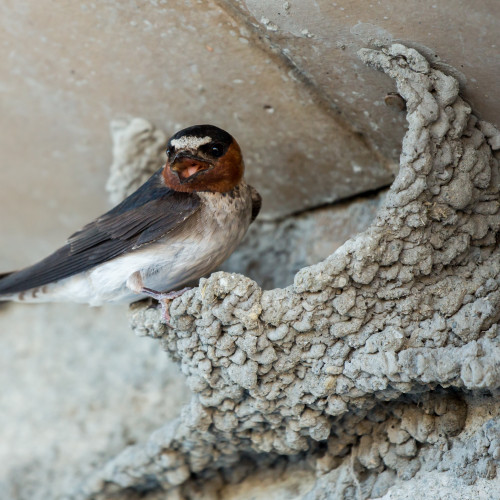Urban, Mud, and Scrape Nests
LOOK AROUND
What kinds of materials do you see on the ground that would make a good nest?

Birds will use whatever materials are around to build their nests, including trash.
Photograph by K. Steudal / CC BY 2.0
A
Urban Nests
Birds are resourceful and will use whatever materials are available to build their nests, including trash. These nests are particularly common in urban environments. Trash can have unexpected benefits—for example, cigarette butts can help reduce ticks, mites and other pests—but it can also cause birds to get entangled or choke.
Who Lives Here?
Birds that live in nests incorporating trash include the Carolina wren (Thryothorus ludovicianus), house sparrow(Passer domesticus), rock pigeon (Columba livia), European starling (Sturnus vulgaris), and American crow (Corvus brachyrhynchos).
B
Mud Nests
Mud nests are made by combining mud pellets with other materials, including grass, bark, hair, or feathers. They are durable and can stick to vertical surfaces, such as cliffs or the walls of buildings.
Who Lives Here?
Birds that live in mud nests include the barn swallow (Hirundo rustica), cliff swallow (Petrochelidon pyrrhonota), and cave swallow (Petrochelidon fulva).

Barn Swallow in a mud nest
Photograph by Y Helfman
C
Scrape Nests
Some birds make their nests by scraping a shallow hole in the ground. Because of the danger of predators, these nests are usually made by birds whose offspring are able to leave the nest quickly after hatching.
Who Lives Here?
Birds that live in scrape nests include the Canada goose (Branta canadensis), killdeer (Charadrius vociferous), mallard(Anas platyrhynchos), and great black-backed gull (Larus marinus).

Canada goose atop a nest
Photograph by Holey
Nidos urbanos, de barro y de paisaje
Mire a su alrededor
¿Qué tipo de materiales ve en el suelo que servirían para hacer un buen nido?

Las aves utilizarán cualquier material que tengan a su alcance para construir sus nidos, incluida la basura.
Fotografía de K. Steudal / CC BY 2.0
A
Nidos urbanos
Las aves son ingeniosas y utilizarán cualquier material disponible para construir sus nidos, hasta basura. Estos nidos son especialmente comunes en los entornos urbanos. La basura puede tener beneficios inesperados —por ejemplo, las colillas de cigarrillos pueden ayudar a reducir las garrapatas, los ácaros y otras plagas— pero también puede hacer que los pájaros se enreden o se ahoguen.
¿Quiénes viven aquí?
Las aves que viven en nidos que incorporan basura son el cucarachero de Carolina (Thryothorus ludovicianus), el gorrión común (Passer domesticus), la paloma bravía (Columba livia), el estornino pinto (Sturnus vulgaris) y el cuervo americano (Corvus brachyrhynchos).
B
Nidos de barro
Los nidos de barro se hacen combinando gránulos de barro con otros materiales, como hierba, corteza, cabello o plumas. Son duraderos y pueden adherirse a superficies verticales, como acantilados o paredes de edificios.
¿Quiénes viven aquí?
Las aves que viven en nidos de barro incluyen la golondrina común (Hirundo rustica), la golondrina risquera(Petrochelidon pyrrhonota) y la golondrina pueblera (Petrochelidon fulva).

Golondrina en un nido de barro
Fotografía de Y Helfman
C
Nidos escarbados
Para hacer sus nidos, algunas aves excavan un agujero poco profundo en el suelo. Debido al peligro que representan los depredadores, estos nidos suelen ser hechos por aves cuyas crías pueden abandonar el nido rápidamente después de la eclosión.
¿Quiénes viven aquí?
Las aves que viven en nidos escarbados son el ganso de Canadá (Branta canadensis), el chorlo gritón (Charadrius vociferous), el pato de collar (Anas platyrhynchos) y el gavión atlántico (Larus marinus).

Ganso de Canadá encima de un nido
Fotografía de Holey












